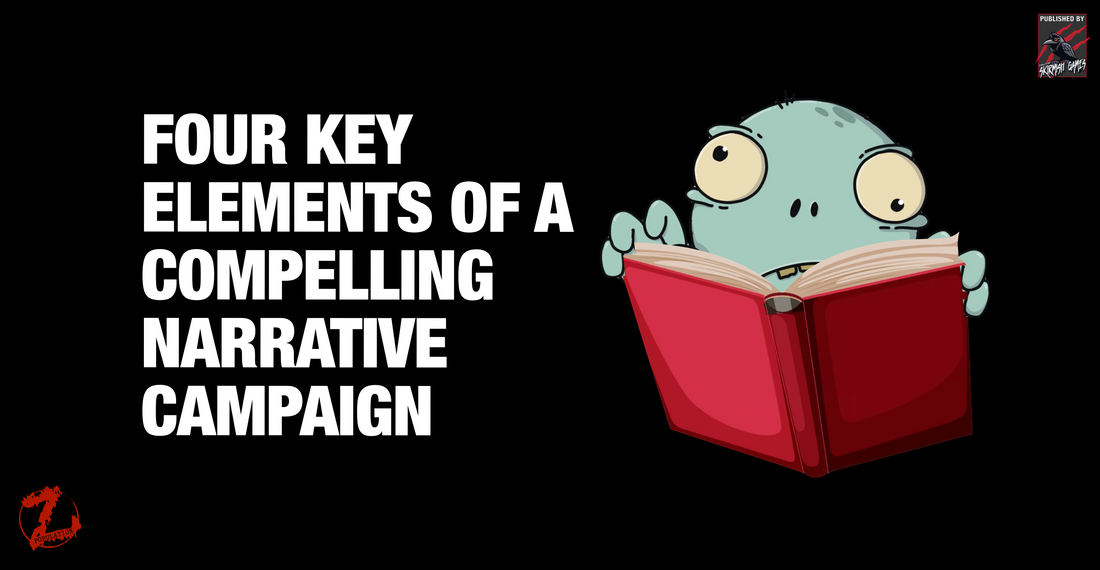Four Key Elements Of A Compelling Narrative Campaign
Narrative campaign play in tabletop skirmish games adds depth, storytelling, and progression to the gaming experience. Players will create and develop their characters as they find new gear and enhance their abilities. They'll follow a story arc and make meaningful decisions that have an effect on how the plot develops. The players are kept motivated and challenged with new scenarios and game mechanics that enhance the story and drive the game forward.
In this blog post, we’ll look at four key elements that contribute to a compelling narrative campaign. As game creators, it’s important to spend time thinking about these elements and making our campaigns much more than a mere series of battles.
With that in mind, let’s first define narrative. Narrative is defined as, a spoken or written account of connected events; a story. In tabletop skirmish games, players use campaigns and skirmishes to make an account of the events and experiences of their characters. Game creators set the stage, place the props, set the boundaries, and then it’s up to the players to improvise and act out the scene.
Now, let’s look at the four key elements that contribute to a compelling narrative campaign in tabletop skirmish games.
1. Story Arcs and Plot Development
A narrative campaign begins with a captivating introduction or backstory that sets the stage for the players. This could involve a mysterious event, an impending threat, or a quest that requires the characters' attention.
The campaign unfolds through interconnected story arcs, each presenting unique challenges, objectives, and revelations. These arcs create a sense of progression and keep players engaged as they navigate through the evolving narrative.
In Population Z, my solo/co-op zombie survival tabletop skirmish game, players are thrown right into the start of the outbreak and then have to gather essential supplies before finally escaping the town of Huntsville and heading out into the unknown. Their choices have consequences, and success - or failure - in each scenario will have a big impact on the campaign, especially the final big boss battle!
2. Character Progression and Development
Players often start with a basic set of characters or warbands, each with its own background and motivations. As the campaign progresses, characters can evolve based on their experiences and achievements.
Incorporate personal storylines for individual characters within the broader campaign narrative. This could involve character-specific quests, rivalries, alliances, or even internal conflicts, adding a layer of personal investment for the players.
In Population Z, you can download free backstories and scenarios to play out using new characters that we create for you. Playing these scenarios makes it much more interesting when you want to add a new character to your group. They’ll come with experiences and backgrounds, and you’ll have already made a connection with them on an emotional level.
3. Consequence and Decision-Making
Introduce decision points where players must make choices that impact the unfolding story. These choices could affect alliances, resources, or the overall direction of the campaign. The element of consequence adds a dynamic and unpredictable quality to the narrative.
Carry over consequences from one game to the next. Whether it's the aftermath of a battle, the loss of a key ally, or the discovery of a new location, these persistent effects contribute to the campaign's continuity.
In Population Z, failure to achieve certain objectives or leaving a survivor behind means that the characters will have to roll on a ‘Guilt Table’. The level of guilt they feel will have an impact on certain characteristics going in to the next skirmish.
4. Evolving Game Mechanics and Scenarios
Design a variety of scenarios that reflect different aspects of the campaign's story. These scenarios could involve rescue missions, territory control, or special objectives tied to the overarching narrative.
Gradually increase the challenges faced by players. Introduce new adversaries, environmental hazards, or unexpected twists that force players to adapt and strategise. This evolution keeps the campaign dynamic and prevents it from becoming predictable.
In Population Z, survivors will encounter new Zombies that ‘belong’ to the location. Each new Zombie will bring a mechanic that plays into the narrative and forces the players to think differently and try out new tactics.
Four Key Elements Of A Compelling Narrative Campaign
By incorporating these four elements into your narrative campaigns, you can create a rich and immersive experience for players, blending strategic gameplay with a compelling storyline. The ongoing nature of the campaign allows for a deeper connection to the game world and characters, making each session more meaningful and memorable.
In Population Z, the narrative campaign is the most important part of the game, and I’ve spent more time developing the scenarios and campaign than any other part of the book. Once the core rules are learned, the players will spend most of their time with the campaign rules, scenarios, NPCs, and their characters, so it was critical to get it right.
As we get closer to the release of Population Z in January 2024, I'll create step by step examples and detailed posts and videos on tabletop skirmish game creation. I'll go through the decision making process, highlight play-testing discoveries, and much more.
I’d love to hear your thoughts and opinions on the subject, so join in the conversation in the comments below.
Thanks for reading!
Lee
Look out for my new game, Population Z: Welcome to Huntsville, launching in January 2024.

